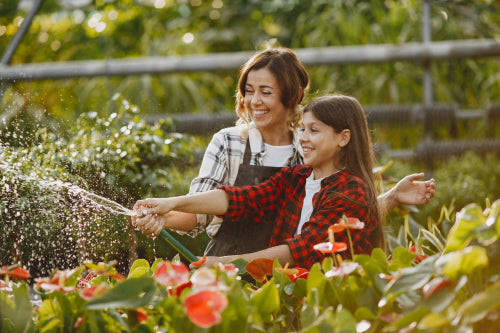Quick Listen:
Water conservation is a critical concern in today's world. With climate change and increasing demand for water resources, it's more important than ever to ensure that we're using water wisely, especially in our gardens. As the planet's population grows, and as water scarcity becomes a looming issue in many regions, every action we take to reduce water usage can make a big difference.
Fortunately, gardeners can play a pivotal role in this effort. By adopting practices and technologies that reduce the need for frequent watering, we can both save water and create more sustainable, resilient gardens. Below are some of the most effective methods to reduce water usage in your garden while maintaining its beauty and health.
1. Mulching to Retain Moisture
Mulch is a simple, yet highly effective strategy for reducing water usage in your garden. It helps conserve moisture, reduce evaporation, and maintain a more consistent soil temperature. Mulching also suppresses weed growth, which can otherwise compete with your plants for water and nutrients.
When applying mulch, it's important to use organic materials like straw, wood chips, grass clippings, or leaves. These materials break down over time, enriching the soil and enhancing its water-holding capacity. Ideally, mulch should be applied in a 2-4 inch layer around your plants, but not so thick that it suffocates the soil or plant roots.
An added benefit of mulching is its ability to improve the structure of the soil. Mulch helps to prevent soil erosion during heavy rains and reduces the need for frequent watering. It's especially useful in hot climates where evaporation rates are high.
2. Choosing Drought-Tolerant Plants
One of the most effective ways to reduce water usage in the garden is by selecting plants that are naturally drought-tolerant. These plants are adapted to survive in dry conditions and require far less water once established. They have deep root system that allow them to access water from deeper in the soil, and many have evolved mechanisms to retain moisture in their leaves and stems.
Some excellent drought-tolerant options include succulents, lavender, yarrow, coneflowers, and many native plants. These plants are well-suited to a variety of garden settings and can add beauty and texture without the need for constant watering.
Before choosing plants for your garden, consider your local climate and soil conditions. Native plants, in particular, are often the best choice because they've evolved to thrive in the specific conditions of your region, making them naturally drought-resistant.
By incorporating more drought-tolerant plants into your garden, you'll not only reduce water usage but also create a low-maintenance, eco-friendly landscape.
3. Installing Efficient Irrigation Systems
A significant amount of water is wasted through inefficient irrigation practices. Sprinklers, while common, often distribute water unevenly, causing some areas to be overwatered while others receive too little. Moreover, sprinklers can easily waste water by spraying sidewalks, driveways, or other areas where it's not needed.
To optimize water usage, consider installing more efficient irrigation systems such as drip irrigation or soaker hoses. These systems deliver water directly to the base of the plants, minimizing evaporation and runoff. Drip irrigation, in particular, is incredibly water-efficient as it uses a network of tubing and emitters to deliver small, consistent amounts of water to the roots of your plants.
Drip systems are also ideal for targeting specific areas of the garden, such as flower beds or vegetable rows, and can be easily adjusted to meet the needs of different plants. The key is to ensure that your irrigation system is properly calibrated and that it runs only when necessarytoo much water is just as wasteful as too little.
Using a timer or a smart irrigation system can further enhance efficiency. These systems can be programmed to water at optimal timesusually early in the morning or late in the evening when temperatures are cooler, and evaporation rates are lower.
4. Watering During Cooler Hours
Speaking of optimal watering times, watering your garden during the early morning or late evening can drastically reduce water loss due to evaporation. During the hot afternoon hours, the sun's heat causes water to evaporate quickly, meaning much of your watering effort is wasted.
In addition to reducing water loss, watering during cooler hours allows your plants to absorb more water, ensuring that they're adequately hydrated before the heat of the day sets in. Watering in the early morning is particularly advantageous because it also helps prevent the growth of mold and mildew, which can thrive in the damp environment created by evening watering.
For even more control over your watering schedule, consider using a soil moisture sensor. These devices help you determine exactly when and how much water your garden needs, avoiding overwatering and ensuring that your plants get just the right amount of moisture.
5. Collecting Rainwater
Rainwater collection is a sustainable and cost-effective way to reduce your reliance on municipal water systems. By setting up a rainwater harvesting system, you can collect water from your roof and store it in barrels or larger cisterns for later use in your garden.
Rainwater is ideal for gardening because it is typically free of chemicals like chlorine and fluoride, which are often present in tap water. Additionally, rainwater is naturally soft and often better for plants than hard water, which can contain salts and minerals that can build up in the soil over time.
To set up a rainwater collection system, you'll need to install gutters and downspouts that direct rainwater into a storage container. Make sure to include a filter to remove debris, and if necessary, use a pump to make the water more easily accessible for irrigation.
Rainwater harvesting can help reduce your water bill and provide an eco-friendly solution to watering your garden. It's a simple and sustainable practice that anyone can implement with minimal effort.
6. Group Plants According to Water Needs
When planning your garden layout, group plants with similar water requirements together. This is known as hydrozoning and allows you to water more efficiently by targeting specific areas of your garden.
For example, plants that require more water, such as vegetable gardens or tropical plants, can be planted together in one section. Drought-tolerant plants, such as succulents and native shrubs, can be grouped in another section, where they will require far less water.
By organizing your garden based on the needs of your plants, you can reduce water waste and ensure that each plant gets the right amount of moisture. This approach can also improve plant health by minimizing the stress that overwatering or underwatering can cause.
Reduce Water Usage
Reducing water usage in your garden is not only about conserving a precious resourceit's about creating a more sustainable, resilient, and eco-friendly landscape. By adopting strategies like mulching, selecting drought-tolerant plants, installing efficient irrigation systems, watering at the right times, and collecting rainwater, you can make a significant impact on your water consumption.
Not only will these practices help you reduce your environmental footprint, but they will also allow you to maintain a beautiful and healthy garden with less effort and expense. As gardeners, we have the power to influence how we use water, and by making thoughtful, informed choices, we can ensure that our gardens continue to thrive for generations to come.
So, whether you're gardening in a dry climate or just looking to conserve water, these strategies can make a difference. Embrace water-efficient practices, and your garden will not only flourish but also serve as a model of sustainability for your community.
You may also be interested in: Hopfenkranz - DerGartenmarkt.de DerGartenmarkt.de
Discover your gardening joy with a top selection. Your joy and green happiness begin here. Shop Now
Powered by flareAI.

